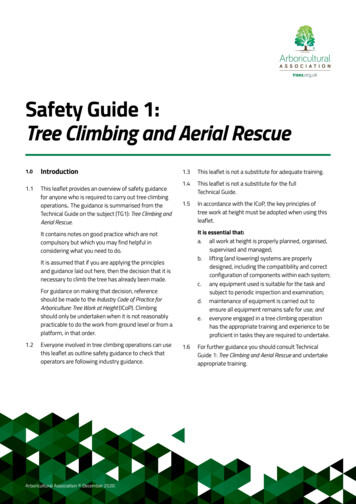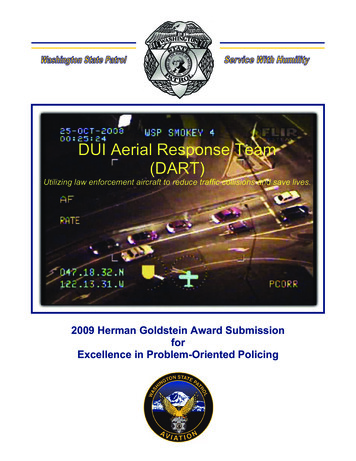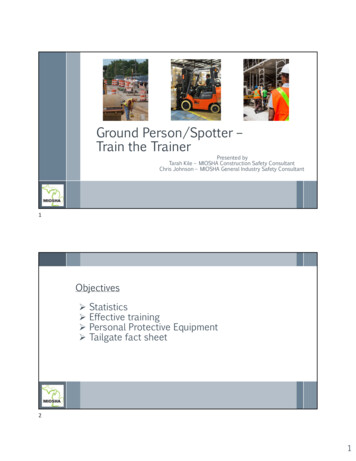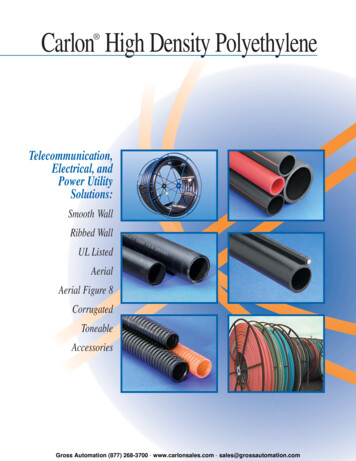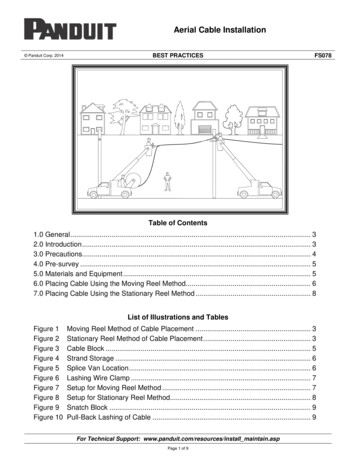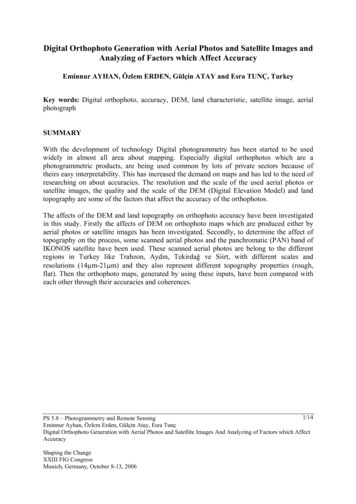
Transcription
Digital Orthophoto Generation with Aerial Photos and Satellite Images andAnalyzing of Factors which Affect AccuracyEminnur AYHAN, Özlem ERDEN, Gülçin ATAY and Esra TUNÇ, TurkeyKey words: Digital orthophoto, accuracy, DEM, land characteristic, satellite image, aerialphotographSUMMARYWith the development of technology Digital photogrammetry has been started to be usedwidely in almost all area about mapping. Especially digital orthophotos which are aphotogrammetric products, are being used common by lots of private sectors because oftheirs easy interpretability. This has increased the demand on maps and has led to the need ofresearching on about accuracies. The resolution and the scale of the used aerial photos orsatellite images, the quality and the scale of the DEM (Digital Elevation Model) and landtopography are some of the factors that affect the accuracy of the orthophotos.The affects of the DEM and land topography on orthophoto accuracy have been investigatedin this study. Firstly the affects of DEM on orthophoto maps which are produced either byaerial photos or satellite images has been investigated. Secondly, to determine the affect oftopography on the process, some scanned aerial photos and the panchromatic (PAN) band ofIKONOS satellite have been used. These scanned aerial photos are belong to the differentregions in Turkey like Trabzon, Aydın, Tekirdağ ve Siirt, with different scales andresolutions (14μm-21μm) and they also represent different topography properties (rough,flat). Then the orthophoto maps, generated by using these inputs, have been compared witheach other through their accuracies and coherences.1/14PS 5.8 – Photogrammetry and Remote SensingEminnur Ayhan, Özlem Erden, Gülçin Atay, Esra TunçDigital Orthophoto Generation with Aerial Photos and Satellite Images And Analyzing of Factors which AffectAccuracyShaping the ChangeXXIII FIG CongressMunich, Germany, October 8-13, 2006
Digital Orthophoto Generation with Aerial Photos and Satellite Images andAnalyzing of Factors which Affect AccuracyEminnur AYHAN, Özlem ERDEN, Gülçin ATAY and Esra TUNÇ, Turkey1. INTRODUCTIONThe advance of computer technology in Digital Photogrammetry, Remote Sensing,Geographical Information Systems, Real Time 3D Digital Model and Visualization Systemshave enhanced undoubtedly in recent years. The applications of this realistic method of realtime visualization could be seen in many fields (engineering, urban and city planning,architecture, design, science and art) (Alexandrov, 2004).Besides, up to date and spatial information can be provided by the help of digitalphotogrammetry using aerial photos and satellite images.The orthophoto maps of digitalphotogrametric production , which are produced by using aerial photographs and satelliteimages, can supply fast and economical map production. Especially the orthophoto maps thatare produced by using satellite images, by means of developing technology, are advancing forbeing economical alternatives to classic maps.Even the updating of digital vector productstakes a short time, at first step the production takes too much time (Akdeniz, 2004).Ortophotos are photographs that have been corrected for distortions due to tilting of thecamera during the photographic survey, distortions from the camera lens, and reliefdistortions. Orthophotos display all the valuable information of a photograph, but unlike aphotograph, true distances, angles and areas can be measured directly (Rossi,2004).To use these orthophoto images as a map, it is of great importance to provide orthophotoimages in high level of accuracy. A qualified orthophoto can be generated with the compoundof selecting the right parameters, operator’s talent and operator’s experience. The quality ofDEM which is another factor affects the quality of the orthophoto image can be changethrough scanning resolution, control parameters used in image matching, quality ofphotograph, density of DEM points and land characteristics. The planimetric spacing(density) of the DEM posts also control the accuracy of the surface model. Increasing theresolution of the DEM and decreasing the spacing between neighbouring points not onlyincreases the file size and generation time, but also noticeably the detail that is recorded andreduces the effect of smoothing (Smith, 1997). In this study the affects of data which are usedduring orthophoto generation, on the accuracy of orthophoto image has been investigated.2. METHODOLOGYIn that study five different regions has been determined through their topography structures.Aerial photos in different scales, different properties and different resolutions have been usedwith Ikonos PAN band, and with DEM which were produced by different methods to produce2/14PS 5.8 – Photogrammetry and Remote SensingEminnur Ayhan, Özlem Erden, Gülçin Atay, Esra TunçDigital Orthophoto Generation with Aerial Photos and Satellite Images And Analyzing of Factors which AffectAccuracyShaping the ChangeXXIII FIG CongressMunich, Germany, October 8-13, 2006
digital orthophoto images. The affects of these data on orthophoto images were researched.The regions and their properties which were used in this study is illustrated in Table 1.Table 1: Working areas and their rey ToneInfrared2 (Aydın)FlatMediumColored3 (Tekirdağ)FlatLargeBlack-white4 (Siirt)FlatLargeBlack-whiteRough FlatPANBlack-white5 (Trabzon)Used DEMAvailableGenerated from astereo modelGenerated from astereo modelGenerated from astereo modelGenerated from astereo modelThe images have been oriented and rectified with using Z/I Imaging which is a DigitalPhotogrammetric Software. Specially Image Station Digital Measuration (ISDM) and ImageStation Photogrammetric Manager (ISPM) modules have been used for orientating andrectifying the images. Orthophoto generation, which is the next step, has been generated withImage Station Base Rectifier (ISBR) module. The properties of the Aerial-Photos used in thisapplication have been shown in Table 2.Table 2: The properties of the Aerial-Photos used in applicationCityScaleGrey iteImageResolution21μm21μm14μm21μm2.1. Working Area-1A roughly place belong to Trabzon City has been chosen as Working Area 1. Together withits roughness, it has been urbanized and densely vegetated area. For this area, an aerial photowhich is in 1/16000 scale, which is infrared and which has 21μm resolution, has been used.Both the calibration information which belongs to the camera, and photograph informationhave been used as input data for ISPM module. Besides this, projection information anddatum information of the area have been recognized with the same module. Then, allorientations (interior, relative and absolute) of the project have been done in ISDM module. 7control points have been used during absolute orientation. The homogeneity of the points’3/14PS 5.8 – Photogrammetry and Remote SensingEminnur Ayhan, Özlem Erden, Gülçin Atay, Esra TunçDigital Orthophoto Generation with Aerial Photos and Satellite Images And Analyzing of Factors which AffectAccuracyShaping the ChangeXXIII FIG CongressMunich, Germany, October 8-13, 2006
distributions and the clearness of the points have been considered while choosing thesepoints.The DEM in Figure 1 has been generated with the help of high altitude information belong tothe 1/1000 scaled present time map which is belong to the region 1. Then, Digital TerrainModel (DTM) has been produced by using the generated DEM. Ortho photo processing hasbeen achieved in Z/I Imaging software by using DEM, DTM and aerial photo in ISBRmodule.Figure 1: DTM file used in Ortho Photo processing (Working Area -1)The two aerial photos which include the same area with the region we have made Orthophoto, have been intersected with DEM due to achieve Mosaic process (Figure 2). 30 fieldtest points have been signed over this mozaiked image and their X,Y,Z coordinates have beenmeasured. These used field test points have been shown in Figure 3.Figure 2: Intersection of the image with DEM file (Working Area 1 )4/14PS 5.8 – Photogrammetry and Remote SensingEminnur Ayhan, Özlem Erden, Gülçin Atay, Esra TunçDigital Orthophoto Generation with Aerial Photos and Satellite Images And Analyzing of Factors which AffectAccuracyShaping the ChangeXXIII FIG CongressMunich, Germany, October 8-13, 2006
Figure 3: Working Area and field test points (For Working Area 1 )In the result of the accuracy analysis on defined test field points in working area, mean squareerrors of the differences of generated orthophoto image with stereo model and fieldcoordinates have been illustrated in Figure 4.Comparing Mean Square ErrorsError (m)(Planimetric and Height)2.01.51.00.50.0Difference ofField and OrthoPhoto (m)Mean Planimetric ErrorDifference ofStereo view and Orthophoto(m)Mean Height ErrorFigure 4: Comparing of Mean Square Errors (Planimetric and Height) (Working Area 1)2.2. Working Area - 2The second working area is Aydin city centre which is rather flat with dense urbanization.The aerial photos belong to that area are coloured photos in 1/1000 scale with 21μm scanningresolution and were taken in 2001. The used field test points are the original control pointswhich were measured with geodetic techniques and signed clearly during photograph taking.The processes which were done in working area 1 has been repeated fort his area, too. 35field test points have been used during the absolute orientation.5/14PS 5.8 – Photogrammetry and Remote SensingEminnur Ayhan, Özlem Erden, Gülçin Atay, Esra TunçDigital Orthophoto Generation with Aerial Photos and Satellite Images And Analyzing of Factors which AffectAccuracyShaping the ChangeXXIII FIG CongressMunich, Germany, October 8-13, 2006
In the Stereo evaluation stage, heights of some points, which precisely represent the terrain,have been determined. With the help of these points DTM file was formed manually fororthophoto. Then, orthophoto process was done with using pixel by pixel ortho rectificationmethod. Next orthophoto images were intersected with contours and mosaic was done. Ascan be seen in Figure 5, 30 test field points have been chosen and their coordinates have beenmeasured both in stereo and orthophoto image.Figure 5: Working area and field test points (Working area -2)The mean square errors of the differences between stereo model and orthophoto images havebeen illustrated in Figure 6.MEAN SQUARE ERRORSError (m)1.61.41.21.00.80.60.40.20.0Mean Planimetric Error(m)Mean Height Error(m)Figure 6: The mean square errors of stereo model and orthophoto6/14PS 5.8 – Photogrammetry and Remote SensingEminnur Ayhan, Özlem Erden, Gülçin Atay, Esra TunçDigital Orthophoto Generation with Aerial Photos and Satellite Images And Analyzing of Factors which AffectAccuracyShaping the ChangeXXIII FIG CongressMunich, Germany, October 8-13, 2006
2.3. Working Area – 3The third working area is in Tekirdağ-Çorlu region which is very flat and densely urbanised.The aerial photos used for that part of the study is black and white in 1/5000 scale. They hadbeen taken for the aim of making present time maps of the region in 2001.Control points had been signed on the terrain clearly and measured with geodetic methodsprecisely before the photogrammetric flight. The steps in working area-1 and working area-2,has been repeated for this area. The result of the absolute orientation was considerably good.Stereo evaluation process has been done like in the second working area. Then DTM hasbeen generated and orthorectified with using pixel by pixel orthorectification method. As inFigure 7, homogeneously distributed 18 field test points have been located on the model andthe measurements which were taken from both stereo image and orthophoto image have beencompared.Figure 7: Working area and test field points (Working area - 3)The mean square errors of the differences between stereo model and orthophoto images havebeen illustrated in Figure 8.MEAN SQUARE ERRORSError (m)0.80.80.80.80.70.70.7Mean Planimetric Error(m)Mean Height Error(m)Figure 8: The mean square errors of stereo model and orthophoto7/14PS 5.8 – Photogrammetry and Remote SensingEminnur Ayhan, Özlem Erden, Gülçin Atay, Esra TunçDigital Orthophoto Generation with Aerial Photos and Satellite Images And Analyzing of Factors which AffectAccuracyShaping the ChangeXXIII FIG CongressMunich, Germany, October 8-13, 2006
2.4. Working Area -4The fourth working area belongs to the Siirt city which has also a flat topography. Black andwhite aerial photos, taken in 2002 with the scale of 1/5000 were used in this stage. In additionto its flatness, there is parse urbanization. The images belong to a military area.Control points had been signed in the terrain clearly and measured with geodetic methodsprecisely before the photogrammetric flight. All the steps in other working areas have beenrepeated for this area, too. 8 control points have been used for the absolute orientation.In stereo evaluation process, contours have been generated manually. DTM has been formedwith the help of these contours and orthorectified by pixel by pixel orthorectification method.Then mosaicing process has been achieved successfully.The coordinates of 16 test field points (Figure 9) on stereo and orthophoto image have beenmeasured and the differences have been compared.Figure 9: Working area and field test points (Working area -4)The mean square errors of the differences between stereo model and orthophoto images havebeen illustrated in Figure 10.8/14PS 5.8 – Photogrammetry and Remote SensingEminnur Ayhan, Özlem Erden, Gülçin Atay, Esra TunçDigital Orthophoto Generation with Aerial Photos and Satellite Images And Analyzing of Factors which AffectAccuracyShaping the ChangeXXIII FIG CongressMunich, Germany, October 8-13, 2006
MEAN SQUARE ERRORSError (m)0.90.80.70.60.50.40.30.20.10.0Mean Planimetric Error(m)Mean Height Error(m)Şekil 10: Stereo model-Ortofoto karesel ortalama hatalarFor the four working areas where aerial photos were used, the calculated mean square errorswere illustrated in Figure 11.Mean Square Errors in 4 Working İRDAĞSİİRTWorking Areasdp 2dz 2Figure 11: Mean Square Errors through the working areas2.5. Working Area -5The fifth and the last working area is in the Trabzon city. The PAN band of the IKONOSsatellite image in 1m spatial resolution has been used. In this stage, DTM has been generatedfrom an existing 1/25000 scaled DTM and pixel by pixel orthorectification has beengenerated with the using of DEM, DTM, and Image. Points have been measured both on therough and flat areas and have been compared with present time maps. The affects of the usedDTM after an orthophoto process, on both PAN image and aerial photo has been alsoinvestigated. The derived results have been illustrated in Figure 12.9/14PS 5.8 – Photogrammetry and Remote SensingEminnur Ayhan, Özlem Erden, Gülçin Atay, Esra TunçDigital Orthophoto Generation with Aerial Photos and Satellite Images And Analyzing of Factors which AffectAccuracyShaping the ChangeXXIII FIG CongressMunich, Germany, October 8-13, 2006
MEAN SQUARE aphyRoughFlatFlatFigure 12: Mean Square Errors on Terrain and Orthophoto (Working Area 5)3. RESULTS AND DISCUSSIONIn this study, the accuracies of orthophoto maps produced at 5 areas have been compared.The images belonging to different areas have differences about scale, gray tone, topographystructure, used DEM at obtained models’ average errors. All of these are the components thathave direct effect on orthophoto maps’ accuracy.To determine the accuracies of orthopoto maps at 5 working areas, aerial photos 30 testpoints in Trabzon, 30 points in Aydın, 18 points in Tekirdağ, 16 points in Siirt; and also 13test points belongs to Trabzon Ikonos panchromatic band image have been selected. Testpoints have been selected from among points to be selected easily on photo like road, groundcorners and so errors in readings have been reduced. But at some working areas selectingdetails has been limited because of intensive structuring. For obligatory situations buildingcorners have been selected as test points. This situation has been affected the results negative.DEM data obtained from terrestrial measurements has been used at working area-1. At otherworking areas because of the fact that scales of aerial photos have been large, DEM obtainedfrom stereo model has been used for orthophoto. At working area-1 because of the smallscale and having near infrared character, the accuracy of orthophoto map has been affectednegative. To evaluate stereo model from a near infrared image has harder and more difficultthan a panchromatic image. Difficulties on marking points have affected the coordinates.Because of small scale has reduced resolution of the image, so the details have beendetermined approximately. In forming model process from being used control points whichare on side of model have big error so that maximum dx difference between geodeticmeasurement coordinates and orthophoto coordinates is 2,892m. dz difference betweengeodetic measurement coordinates and stereo model coordinates is 2.90m. The errors ofX,Y,Z have increased on sides of model.10/14PS 5.8 – Photogrammetry and Remote SensingEminnur Ayhan, Özlem Erden, Gülçin Atay, Esra TunçDigital Orthophoto Generation with Aerial Photos and Satellite Images And Analyzing of Factors which AffectAccuracyShaping the ChangeXXIII FIG CongressMunich, Germany, October 8-13, 2006
Aerial photos belonging to working area-2 have been different from others about beingcolored. Because of the photos used for evaluation were taken for the present time map andthe control points were distributed to model well, errors of points used absolute orientationare for X 0.054m., for Y 0.051m. and for Z 0.081m. DEM used for orthophoto has beenproduced as photogrammetric from stereo model. There have been high buildings in the citycenter. Shadows of them have obstructed marking points and affected stereo and orthophotoevaluation negative. Errors have increased at model sides. Marking points at Z could not beendone correctly, maximum error has been 1.555m. As for root mean square error (rmse),because of the shadow of high buildings that have covered details, it has been seen thatplanimetric error 1.407m. has been bigger than height error 0.652m.Aerial photos belonging to working area-3 has been taken for the present time map and had14µm. resolution. The resolution is better than working area-2’s photos have. Because ofstructuring, problems on marking points have been similar with working area-2. Because ofthe buildings’ shadows coverage, marking points could not been done precisely. At the end ofabsolute orientation, errors have been 0.013 m. at x direction, 0.018 at y direction and 0.033at z direction. DEM used for orthophoto has been produced from stereo modelphotogrammetrically. Planimetric mean square error of test points has been 0.802m. andheight root mean square error has been 0.742m. They have been approximately equal.Working area-4 has infrequent settlement. Aerial photos have been scanned as black andwhite. Absolute orientation results have been better than the other working areas. DEM usedfor orthophoto has been produced from stereo model photogrammetrically. DTM file hasbeen obtained from contour lines. The aerial photos’ resolution of this working area havebeen worse than the others’ photos. The effect of shifting of point owing to elevationdifference has been increased on sides of model. Planimetric mean square error at test pointshas been 0.804m. and height root mean square error is 0.413m. The working area is flat andDTM has been obtained from contour lines thus accuracy of height has been increased.When mean errors of this four working areas have been compared, it has been seen thatworking area-4 has the best accuracy. Accuracy of marking points has been increasedbecause of being flat area and there have not been very high buildings there. Besides, becauseof the fact that DTM file has been obtained from contour lines, accuracy of orthophoto mapshas been increased. Working area-2 and 3 have flat topography but because of intensivestructuring have made marking points difficult. This has affected the accuracy of orthophoto.The height root mean square error for working area-2,3 and 4, with flat topography, are0.652m., 0.742m. and 0.413 respectively, the height root mean square error working area-1,with uneven topography, is 1.576m. When topography gets flat, magnitude of errordecreases. Magnitude of planimetric error amount has been minimal at working area-3. It hasoccurred because of aerial photo’s resolution.Besides mean error of values measured rough area have been bigger than flat area as seenworking area-5. While root mean square error of measurements selected rough area onorthophoto produced by using panchromatic image has been 3.069, mean square error of11/14PS 5.8 – Photogrammetry and Remote SensingEminnur Ayhan, Özlem Erden, Gülçin Atay, Esra TunçDigital Orthophoto Generation with Aerial Photos and Satellite Images And Analyzing of Factors which AffectAccuracyShaping the ChangeXXIII FIG CongressMunich, Germany, October 8-13, 2006
measurements selected flat area have been 1.092m. When topography gets flat, magnitude oferror decreases. DEM used for this area have produced from geodetic points. Used DEM’squality has affected the accuracy of orthophoto significantly. Being used image resolution is1m. and DEM with low quality also accuracy of operator’s marking points have had badeffect on error. There have been some points with wrong height values on produced DEM orareas with few control points haven’t shown the topography correctly. So that these areashave been seen disordered. This situation can be seen clearly on Figure13.a)b)Figure 13: DEM; a) aerial photo (working area-1) b) The effects of points with wrong height valueand with few control points satellite image to orthophoto image4. CONCLUSIONSOrthophoto maps are preferred by lots of disciplines in point of to see details, ease clarity.Increasing interest is necessitated to investigate their accuracies. For this purpose in thisstudy, the effects of used data on produced orthophoto accuracies of maps have beensearched. As a result of this study, because of the high reflection of near infrared aerialphotos have made difficult distinction of details, in addition because of small scale and nodetermined control points before the flight, to get desired accuracy has not been possible. Ithas been seen that the reflection in panchromatic photos is few. Evaluation is executed in asmall time and the accuracy has been increased. When the scale gets small, the error quantityincreases; when scan resolution gets increase, the error quantity decreases. The results arebetter at flat areas than rough areas in topography. Besides, contour lines which have beendrawn manual from the stereo model have better results than DEM data which have beenformed from random points on stereo model.Accuracy of obtained model and DEM data are the most important components of affectingthe accuracy of orthophoto. Accuracy of models is related to control points’ accuracy. Notbeing optimum density and homogenous distribution of ground control points have affectedthe accuracy of orthophoto.12/14PS 5.8 – Photogrammetry and Remote SensingEminnur Ayhan, Özlem Erden, Gülçin Atay, Esra TunçDigital Orthophoto Generation with Aerial Photos and Satellite Images And Analyzing of Factors which AffectAccuracyShaping the ChangeXXIII FIG CongressMunich, Germany, October 8-13, 2006
When used large scale high resolution image, high accuracy DEM and control points, highaccuracy orthophoto maps will be produced.The resolution of used aerial photos is higher than Ikonos satellite panchromatic band image.For high accuracy works, aerial photos are perfect. But to get aerial photos and preparationphases are costly and take up little time. So, if high precision is not important for a study,orthophoto images produced from satellite images are ideal.REFERENCESAkdeniz, H., The Opportunities That Digital Orthophotos Can Supply In Urban Planning,XXth ISPRS Congress, 12-23 July 2004, İstanbul, PS WG rs/112.pdf,Alexandrov, A., Hristova, T., Ivanova, K., Koeva, M., Madzharova, T. and Petrova V., H.,Aplication Of Quickbird Satellite Imagery For Updating Cadastral Information, /160.pdfRossi, Tiffiny Ann, Application Of Digital Photogrammetric Methods İn The Of Land CoverChange On The Coastal Dunes Of Warren Dunes State Park, Berrien Country, MasterThesis,The Michigan State University, Michigan, 2004Sivri, Tayfur, Investigating The Accuracies Of Digital Orthophoto Maps Producted atDifferent Regions, Master Thesis , K.T.Ü., The Graduate School of Natural andApplied Sciences, Trabzon, 2004Smith, M.J., Smith, D.G., Tragheim D.G. and Holt, M., DEMs And Ortho-İmages FromAerial Photographs, Photogrammetric Record, 15 (1997) 945-950BIOGRAPHICAL NOTESEminnur Ayhan is an Assistant Professor at Karadeniz Technical University (KTU),Turkey. She graduated from the Department of Geodesy and Photogrammetry Engineering atKaradeniz Technical University (KTU) in 1983. She got her M.Eng. degree in 1985 andPh.D. degree in 1996 from the same department. She is currently working at the Departmentof Geodesy and Photogrammetry Engineering at KTU. Her interest areas arePhotogrammetry, Close-Range Photogrammetry, Remote Sensing, Image Processing,Classification and Radar.Özlem Erden is Ms.C. student at Karadeniz Technical University (KTU), Turkey. Shegraduated from the Department of Geodesy and Photogrammetry Engineering at KaradenizTechnical University (KTU) in 2003. Her interest areas are Photogrammetry, DigitalPhotogrammetry, Close-Range Photogrammetry, GIS and Remote Sensing.Gülçin ATAY is a Ph. D. student at Karadeniz Technical University (KTU), Turkey. Shegraduated from the Department of Geodesy and Photogrammetry Engineering at KaradenizTechnical University (KTU) in 2001. Her interest areas are Remote Sensing, Digital ImageProcessing and Photogrammetry.13/14PS 5.8 – Photogrammetry and Remote SensingEminnur Ayhan, Özlem Erden, Gülçin Atay, Esra TunçDigital Orthophoto Generation with Aerial Photos and Satellite Images And Analyzing of Factors which AffectAccuracyShaping the ChangeXXIII FIG CongressMunich, Germany, October 8-13, 2006
Esra Tunç is a Ph. D student at Karadeniz Technical University (KTU), Turkey. Shegraduated from the Department of Geodesy and Photogrammetry Engineering at KaradenizTechnical University (KTU) in 2000. She got her M. Sc degree from the Department ofGeodesy and Photogrammetry Engineering at Karadeniz Technical University (KTU) in2003. Her interest areas are Photogrammetry, Close-Range Photogrammetry, RemoteSensing, Geographical Information Systems, SAR, and Radar.CONTACTSEminnur AyhanKaradeniz Technical UniversityDepartment of Geodesy and Photogrammetry Engineering61080 TrabzonTURKEY.Tel. 90 462 3772799Fax: 90 462 3280918Email: eayhan@ktu.edu.trÖzlem ErdenKaradeniz Technical UniversityDepartment of Geodesy and Photogrammetry Engineering61080 TrabzonTURKEY.Tel : 90 462 3772764Fax: 90 462 3280918Email: oerden@ktu.edu.trGülçin AtayKaradeniz Technical UniversityDepartment of Geodesy and Photogrammetry Engineering61080 TrabzonTURKEY.Tel.: 90 462 3772766Fax: 90 462 3280918Email: gatay@ktu.edu.trEsra TunçKaradeniz Technical UniversityDepartment of Geodesy and Photogrammetry Engineering61080 TrabzonTURKEY.Tel.: 90 462 3772795Fax: 90 462 3280918Email: etunc@ktu.edu.tr14/14PS 5.8 – Photogrammetry and Remote SensingEminnur Ayhan, Özlem Erden, Gülçin Atay, Esra TunçDigital Orthophoto Generation with Aerial Photos and Satellite Images And Analyzing of Factors which AffectAccuracyShaping the ChangeXXIII FIG CongressMunich, Germany, October 8-13, 2006
regions in Turkey like Trabzon, Aydın, Tekirdağ ve Siirt, with different scales and resolutions (14μm-21μm) and they also represent different topography properties (rough, flat). Then the orthophoto maps, generated by using these inputs, have been compared
